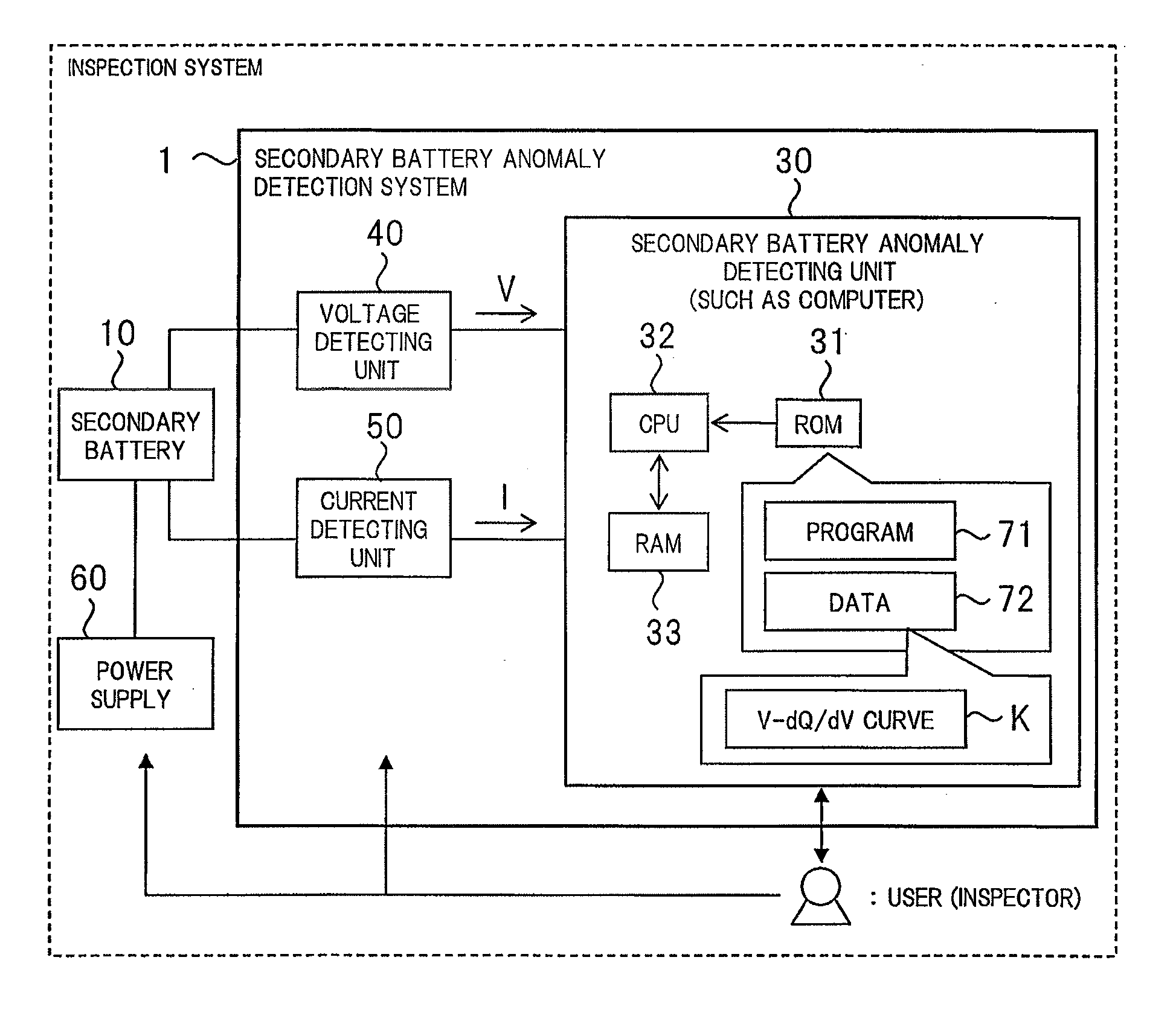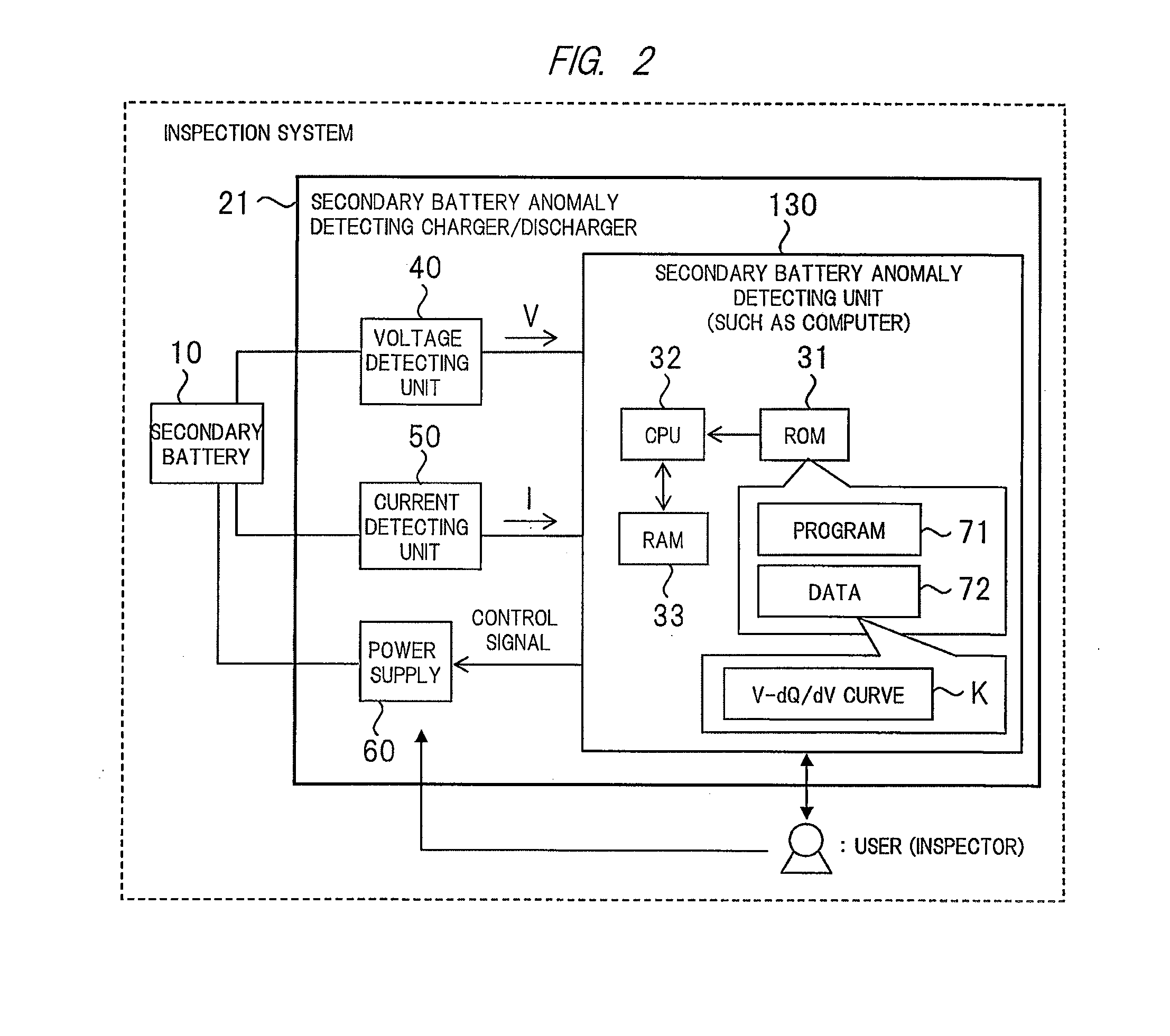Inspection System, Charger/Discharger, and Inspection Method of Secondary Battery
a secondary battery and inspection system technology, applied in the field of second batteries, can solve the problems of increasing cost and no disclosure, and achieve the effects of increasing cost, small degradation in capacity, and fast degradation in capacity
- Summary
- Abstract
- Description
- Claims
- Application Information
AI Technical Summary
Benefits of technology
Problems solved by technology
Method used
Image
Examples
first embodiment
[0032]A secondary battery inspection system and its corresponding inspection method of a first embodiment are described by using FIG. 1, FIGS. 4 to 13, and others.
[0033][System Structure]
[0034]FIG. 1 illustrates an entire structure of a second battery inspection system of the first embodiment. The present inspection system includes an anomaly detection system (a secondary battery anomaly detection system) 1, a secondary battery 10, and a power supply 60 connected to one another. The anomaly detection system 1 includes a voltage detecting unit 40, a current detecting unit 50, and an anomaly detecting unit (a secondary battery anomaly detecting unit) 30. The secondary battery 10 is a single lithium-ion secondary battery to be inspected. Upon inspection, the secondary battery 10 to be inspected is connected to the voltage detecting unit 40, the current detecting unit 50, and the power supply 60. The voltage detecting unit 40 and the current detecting unit 50 are connected to the second...
second embodiment
[0045]FIG. 2 illustrates an example of structure of a charger / discharger 21 (a charger / discharger for detecting anomaly of secondary battery) including a function of detecting an anomaly in a secondary battery as an inspection system of a second embodiment. The charger / discharger 21 includes the function of detecting an anomaly in the secondary battery 10 (such as a voltage detecting unit 40, a current detecting unit 50, and an anomaly detecting unit 130) similar to that of the first embodiment. Furthermore, the charger / discharger 21 has incorporated therein a power supply 60 capable of a charge / discharge operation on the secondary battery 10, allowing control (control of charge / discharge operation) from the anomaly detecting unit 130 to the power supply 60. As described above, the secondary battery 10 is connected to each unit (the voltage detecting unit 40, current detecting unit 50, and power supply 60).
[0046]As with the anomaly detecting unit 30 of the first embodiment, the anom...
third embodiment
[0047]FIG. 3 is an example of a detailed structure of the anomaly detecting unit 30 as an inspection system of a third embodiment. This anomaly detecting unit 30 includes a current input unit 301, a voltage input unit 302, a charged electricity amount calculating unit 303, a dQ / dV calculating unit 304, a dQ / dV feature point calculating unit 305, an anomaly determining unit 306, an anomaly signal output unit 307, a storage unit 310, and others. These units may be each configured as a program module or may be configured of a circuit unit or the like. Also, the structure is such that data information to be processed at each unit (such as 301 to 305) is stored in the storage unit 310 as appropriate. A general outline of the process of the anomaly detecting unit 30 is as follows.
[0048]The anomaly detecting unit 30 receives inputs of the voltage V of the secondary battery 10 detected by the voltage detecting unit 40 and the current I of the secondary battery 10 detected by the current det...
PUM
 Login to View More
Login to View More Abstract
Description
Claims
Application Information
 Login to View More
Login to View More - R&D
- Intellectual Property
- Life Sciences
- Materials
- Tech Scout
- Unparalleled Data Quality
- Higher Quality Content
- 60% Fewer Hallucinations
Browse by: Latest US Patents, China's latest patents, Technical Efficacy Thesaurus, Application Domain, Technology Topic, Popular Technical Reports.
© 2025 PatSnap. All rights reserved.Legal|Privacy policy|Modern Slavery Act Transparency Statement|Sitemap|About US| Contact US: help@patsnap.com



